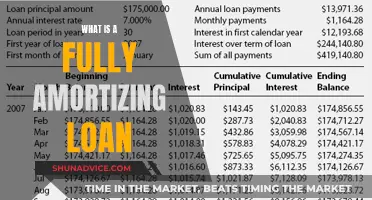
An assumable mortgage is a type of financing arrangement where an outstanding mortgage and its terms are transferred from the current owner to the buyer. This means that the buyer can take on the previous owner's remaining debt and avoid obtaining a new mortgage, which may have a higher interest rate. While most conventional mortgages do not allow for third-party mortgage assumptions, Freddie Mac loans are an exception. All Optigo Small Balance Loans offered by Freddie Mac are assumable with lender approval and a 1% fee. This can be beneficial for both the buyer and seller, as it provides a cost-saving advantage and a quick exit option.
Are Freddie Mac Loans Assumable?
| Characteristics | Values |
|---|---|
| Types of Loans | FHA, VA, and USDA Loans |
| Freddie Mac Loans | Not assumable |
| Requirements for Assumable Freddie Mac Small Balance Loans | Lender approval and a 1% fee |
| Benefits of Assumable Freddie Mac Small Balance Loans | Avoiding prepayment penalties, not repeating the entire loan approval process, and not ordering new third-party reports |
| Application Process | Streamlined |
| Offerings | Hybrid ARM and fixed-rate options, up to 80% LTV allowance, non-recourse, interest-only options, and 30-year amortizations |
| Person Assuming the Mortgage | Needs to qualify with the lender before assuming the existing loan |
| Mortgage Qualification Process | Based on the 4 C's: capacity to pay back the loan, capital, collateral, and credit |
| Third-Party Mortgage Assumption | Rare cases where a seller may offer a mortgage assumption if their existing loan's mortgage rate is more attractive than the current loan market |
What You'll Learn

Benefits of Freddie Mac loans
The Federal Home Loan Mortgage Corporation (FHLMC), commonly known as Freddie Mac, is an American publicly traded, government-sponsored enterprise (GSE). It was created in 1970 to expand the secondary market for mortgages in the US. Freddie Mac buys mortgages, pools them, and sells them as mortgage-backed securities (MBS) to private investors on the open market. This secondary mortgage market increases the money available for mortgage lending and new home purchases.
Freddie Mac loans have several benefits, including:
Avoiding Prepayment Penalties
Freddie Mac loans are assumable, meaning that borrowers can pass on the loan to the next owner of the building instead of paying a prepayment penalty. This is especially beneficial in the first few years of a commercial mortgage when prepayment penalties are high.
Streamlined Application Process
The new owner of a building does not need to go through the entire loan approval process from scratch when assuming a Freddie Mac loan. This also means that they do not need to order new third-party reports, such as appraisals or environmental assessments.
Increased Accessibility
Freddie Mac loans are designed to improve credit flow via mortgages throughout the United States. They achieve this by purchasing mortgage loans from lenders, who then have the funds to generate new loans for homebuyers. This makes mortgage lending less risky for banks and expands the pool of buyers, ultimately making homeownership more accessible and affordable for families.
Variety of Loan Options
Freddie Mac offers a range of loan options, including hybrid ARM and fixed-rate loans, up to 80% LTV allowance, non-recourse loans, interest-only options, and 30-year amortizations. They also have specific programs for multifamily communities, small apartment buildings, affordable housing in underserved areas, and senior housing.
Is Grace Loan Advance a Safe Bet?
You may want to see also

Requirements for Freddie Mac loans
Freddie Mac, established by Congress in 1970, offers several loan programs to make housing more affordable for low- and moderate-income borrowers. The Home Possible program, created in 2014, is one such example. Here are the key requirements for Freddie Mac loans:
Home Possible Loan Requirements
To qualify for a Home Possible loan, borrowers must meet certain eligibility criteria. Firstly, a down payment of 3% is required, which can be sourced from checking and savings accounts, gifts, or grants. Secondly, there is no maximum debt-to-income (DTI) ratio requirement provided by Freddie Mac, but borrowers are recommended to aim for a DTI of 50% or lower. This aligns with the general guideline for qualifying for a mortgage.
Additionally, the loan-to-value (LTV) ratio requirement for this loan type ranges from 80% to 105%. It is important to discuss this with your lender to determine the specific LTV needed for eligibility. Moreover, borrowers are required to pay an annual percentage of the total loan balance as mortgage insurance. This amount is influenced by factors such as the LTV. However, once the total loan amount falls below 80% of the property's appraised value, borrowers can cancel the mortgage insurance.
Eligible property types for the Home Possible loan include single-family homes, multi-unit properties, condominiums, cooperative housing, and manufactured homes. It is important to note that this loan program cannot be used for investment properties, rental properties, or vacation homes. The property must be an owner-occupied primary residence.
Freddie Mac Small Balance Loans Requirements
Freddie Mac Small Balance Loans, such as the Optigo Small Balance Loan, are fully assumable. This means that borrowers can pass on the loan to the subsequent owner of the building instead of paying a prepayment penalty. To assume the loan, the new owner must obtain lender approval and pay a 1% fee. However, if the loan is already several years into its term, the new borrower may need to make a substantial down payment.
Freddie Mac Single-Family Seller/Servicer Requirements
To be considered for approval as a Freddie Mac Single-Family Seller/Servicer, organisations must meet specific eligibility requirements. Applicants must demonstrate their ability to service mortgage loans effectively by maintaining adequate staff and procedures or contracting with a Freddie Mac-approved Servicing Agent. Additionally, applicants must possess Fidelity and Errors & Omissions insurance policies as outlined in the Seller/Servicer Guide.
Freddie Mac maintains the sole discretion to approve institutions as eligible Seller/Servicers. They also reserve the right to modify eligibility criteria or impose additional requirements. Applicants must provide audited financial statements or regulatory reports during the application process, adhering to Freddie Mac's quality control requirements.
Understanding Package Loans: What You Need to Know
You may want to see also

Third-party mortgage assumptions
Similarly, if a property is inherited, the new owner may benefit from assuming the existing mortgage and its terms. This can be advantageous for the borrower as they can pass on the loan to the next owner of the building, thus avoiding prepayment penalties. It is also beneficial for the new owner, who does not need to go through the entire loan application process and can avoid a large down payment.
Freddie Mac Small Balance Loans are also assumable with lender approval and a 1% fee. This includes the Freddie Mac Optigo Small Balance Loan. However, if the loan is already several years into its term, a new borrower may need to make a sizable down payment to assume the loan.
It is important to note that the mortgage qualification process varies depending on an individual's circumstances. Lenders will typically assess an applicant's capacity to repay the loan, their capital, the collateral value of the property, and their credit history.
Becoming a Loan Signing Agent: Texas Requirements and Steps
You may want to see also

Qualifying for a Freddie Mac loan
Freddie Mac, also known as the Federal Home Loan Mortgage Corporation, is a government-sponsored enterprise (GSE). This means that it is backed by the government but is not part of it. Freddie Mac does not directly offer mortgage loans but instead buys mortgages from banks, credit unions, and other financial institutions, which then lend to homeowners.
To qualify for a Freddie Mac loan, there are certain requirements that must be met. Firstly, there is a minimum FICO credit score of 620 needed to qualify, however, applicants with credit scores between 620 and 660 may experience a longer approval process. The down payment for a Freddie Mac loan can be as low as 3%, and this can come from a variety of sources, including family, employer assistance programs, secondary financing, and sweat equity. Additionally, there are no geographic limits on loan amounts.
The Freddie Mac Home Possible® mortgage is designed for very low- to moderate-income borrowers, with qualifying income limited to 80% of the Area Median Income (AMI). The Home Possible Income and Property Eligibility Tool can be used to verify if a borrower can qualify for this mortgage based on the property location and the borrower's income.
Freddie Mac also offers Small Balance Loans, which are fully assumable with lender approval and a 1% fee. This means that the loan can be passed on to the next owner of the building, providing an exit option and avoiding prepayment penalties for the original borrower.
Canceling a Withu Loan: A Step-by-Step Guide to Navigate This Process
You may want to see also

Freddie Mac loan alternatives
Freddie Mac loans are assumable, meaning that the loan can be passed on to the next owner of the building. This is beneficial for the borrower as they can avoid prepayment penalties, and for the new owner as they do not need to go through the entire loan approval process. However, if a loan is already several years into its term, the new borrower may need to make a sizable down payment.
In terms of alternatives to Freddie Mac loans, there are a few options to consider. Firstly, Freddie Mac has been exploring alternatives to repurchase demands, which have been a source of criticism from lenders. The government-sponsored enterprise is looking into ways to handle defective loans while emphasising collaboration and consistency in the sector. While the specifics of these alternatives have not been revealed, it is reported that lenders with exemplary records may be given other ways to deal with defective loan packages. This includes repairing defective but performing loans without requiring their originators to repurchase them.
Another alternative to consider is the Freddie Mac Optigo Small Balance Loan, which is a fully assumable loan with lender approval and a 1% fee. This loan offers a variety of hybrid ARM and fixed-rate options, up to 80% LTV allowance, non-recourse, interest-only options, and 30-year amortizations.
Additionally, Freddie Mac has expanded its repurchase alternative pilot program for performing loans. This program offers a fee-based structure that incentivizes high-quality loan origination and provides an alternative to the traditional single loan repurchase remedy approach. Under this program, lenders will not be required to repurchase most performing loans with significant defects, and small lenders with low NAQ rates will have their fees waived.
Loan Asset Classification and Its Impact on Medicaid Eligibility
You may want to see also
Frequently asked questions
An assumable mortgage is a type of financing arrangement where an outstanding mortgage and its terms are transferred from the current owner to the buyer. The buyer can avoid obtaining their own mortgage, which may have a higher interest rate.
Freddie Mac Small Balance Loans are assumable with lender approval and a 1% fee. However, most conventional mortgages do not allow for third-party mortgage assumptions, including mortgages offered by Freddie Mac.
The borrower can pass on the loan to the next owner of the building instead of paying a prepayment penalty. The new owner will not need to go through the entire loan approval process and can avoid high down payments.
The person assuming the mortgage will need to qualify with the lender before assuming the loan, which includes evaluating their income, employment history, savings, monthly debt payments, and credit history.
Yes, there may be restrictions depending on the specific loan program and the borrower's qualifications. For example, if the loan is already several years into its term, the new borrower may need to make a sizable down payment.







